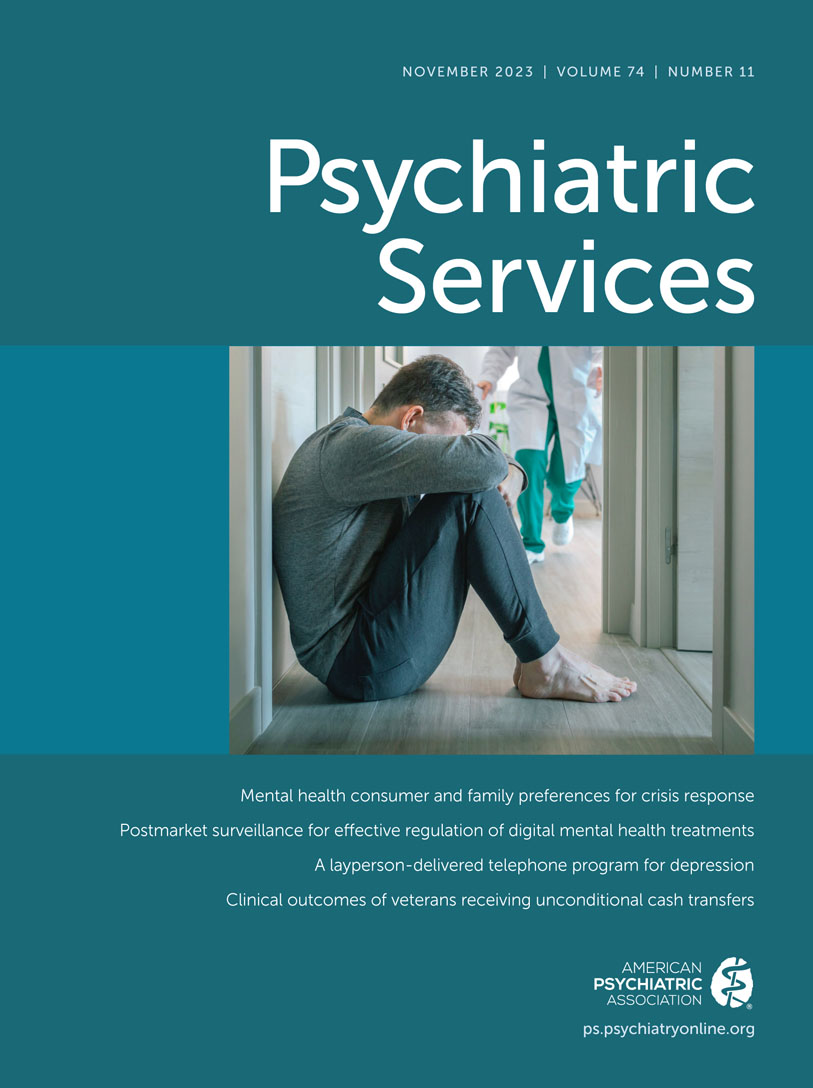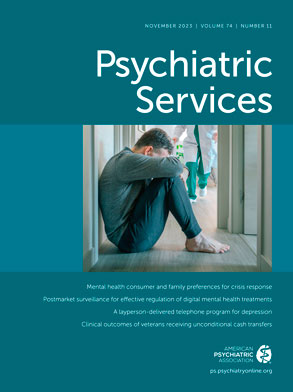People with serious mental illnesses, such as psychosis-spectrum disorders and other mental health challenges requiring long-term mental health care, face significant oral health disparities. They are vulnerable to oral disease risks and have greater oral treatment needs than the general population (
1). Oral health affects mental health through chronic pain, reduced job prospects, feelings of shame and worthlessness, lost workdays, and poor sleep (
2).
Despite robust research demonstrating the benefits of integrating behavioral and medical care (
3), oral health is often left out of the integration landscape. A renewed focus on the oral health of people with serious mental illness is reflected in a national call to address the lack of integration of oral health and behavioral health (
2). Because the health care home of people with serious mental illness is often in behavioral health, community mental health (CMH) clinics or affiliated drop-in centers have great potential to serve as a locus of oral health integration.
Program Description
A psychiatry professor, a dentistry professor, a member of the Michigan Department of Health and Human Services, the executive director of a peer-run drop-in center, and five certified peer support specialists (PSSs) set out to design a sustainable integrated oral health program designed to improve oral health knowledge, self-care behaviors, and service use among people with serious mental illness. We partnered with four PSS-run drop-in centers and one CMH center to design and implement the program. During the planning process, we determined that the program should provide oral health information; elicit intrinsic motivation; connect people to a dental home, usually their closest federally qualified health center (FQHC); and be led by PSSs who can share their “oral health recovery story” to inspire hope.
What makes PSSs unique is their ability to speak from their lived experience of recovery. Studies have shown the effectiveness of PSS-led health interventions (
4) but not specifically for oral health. Our team’s goal was to apply these lessons to an oral health context. The team also foresaw that a PSS-led intervention would ensure the program’s financial sustainability. Because Michigan’s Medicaid Manual discusses health and wellness within PSSs’ scope of practice, normal PSS billing codes could be used to sustain the PSS-led oral health promotion activities.
Because we found no existing programs that had tailored specific elements of oral health interventions by PSSs for adults with serious mental illness, we based our intervention on evidence from settings outside the mental health care system, such as the work of Ponce-Gonzalez and colleagues (
5), whose community health worker–delivered oral health program emphasized social determinants of health and advocacy. We also based our work on evidence from non–oral health promotion programs led by PSSs, such as the blend of education and goal setting found in the Health and Recovery Peer program (
4). In terms of processes, our program emphasized the use of open-ended questions, affirmations, reflective listening, and summaries as described in motivational interviewing (
6) and action planning approaches found in the Whole Health Action Management program (
7). In terms of content, we emphasized the oral health self-care behaviors most amenable to change. For example, the approach includes information about mitigating the harms of a cariogenic diet (e.g., brushing teeth and drinking water after consuming soda) as opposed to having an exclusive focus on changing the cariogenic diet itself (e.g., stop consuming soda), given that cariogenic diets are resistant to change because of their basis in social and commercial determinants of health (
8).
We partnered with a health education nonprofit organization, McMillen Health, to develop oral health educational materials specifically designed to address the challenges experienced by people living with serious mental illness. The goal was to create durable educational materials that could center conversations facilitated by nondental professionals. A community advisory board of five PSSs and other key stakeholders met regularly with the university-based project team to establish the main topics and learning objectives tailored to individuals living with serious mental illnesses. The learning objectives and an outline of content for each topic were then provided to McMillen Health. The graphical design and content teams at McMillen Health developed rough drafts of each page, which were then reviewed and edited by the advisory board and university team. For example, the community advisory board made recommendations on recovery-oriented language, ways to convey hope, ways to better reflect the barriers facing people with serious mental illness or having low incomes, and diversity representation in the featured stock photos.
The result was a 14-page A-frame flipchart, which included consumer-facing photographs and discussion questions on one side and PSS-facing talking points, questions, and oral health information on the other. Each two-page section focused on a different topic, such as “it’s never too late,” “cavities and gum disease,” and “oral health stigma.” Certain pages contained QR code–linked videos of PSSs discussing their oral health recovery stories, which were filmed by McMillen Health media designers during the development process. The online supplement to this column contains an example of a flipchart section titled “It’s Never Too Late.” The foreground shows the consumer-facing page with a large photograph and discussion questions, and the background shows the peer-facing text with guidance on how to discuss the topic. (The online supplement also provides additional information on flipchart content.)
In partnership with the drop-in centers and CMH center, we developed a workflow in which PSSs would provide the flipchart-based oral health educational program to people on their caseloads in an individual or group format. After the intervention, participants were offered oral hygiene kits, donated by a local company, containing a toothbrush, paste, and floss. The PSSs then provided each consumer with information about free, low-cost, or safety-net (Medicaid) dental providers, most of which were FQHCs or dental schools. We developed custom resource lists for each of the five participating sites. PSSs offered all participants help in making a dentist appointment.
We trained 10 PSSs by using a previously developed dental e-learning module (
9) and then discussed with them how to use the flipchart and apply motivational interviewing strategies such as reflective listening. We encouraged the PSSs to consider their own oral health recovery stories and share them with program participants if PSSs felt comfortable doing so.
Evaluation
The program launched in March 2021. We obtained institutional review board review from the University of Michigan, which deemed the project a nonregulated program evaluation. PSSs completed encounter forms after each interaction. At its conclusion, 45 flipchart interventions took place—29 in a group and 16 individually. PSSs could customize which flipchart pages were reviewed, and we found that the top 3 topics selected were “your dental home” (39 encounters), “at-home care” (37 encounters), and “it’s never too late” (35 encounters). Sixteen of the 45 encounters (36%) included the PSSs sharing their oral health recovery story.
Forty-one participants completed preintervention surveys, 38 completed immediate postsurveys, and six completed 3-month postsurveys. The low yield of 3-month surveys stemmed from problems such as nonfunctioning telephone numbers or participants not answering the telephone. Survey items were selected primarily from the PhenX Toolkit (
10).
Table 1 shows the demographic characteristics of participants who opted into taking surveys. At baseline, 44% (N=18) indicated never or rarely discussing oral health with mental health providers. In response to how often teeth were cleaned, responses included never (7%, N=3), 1–3 times per month (10%, N=4), 2–6 times per week (20%, N=8), once per day (34%, N=14), and twice or more per day (29%, N=12). Overall, 37% (N=15) of the respondents reported no dental visits in more than 1 year; 49% (N=20) reported toothache in the past 6 months. Participants described the health of their teeth as poor to very poor (22%, N=9), average (32%, N=13), or good to excellent (44%, N=18).
Health literacy scores improved in several areas, including brushing for at least 2 minutes, not needing to brush hard to clean teeth, not needing a firm or an extra firm toothbrush to clean teeth well, brushing teeth even if you don’t consume food, needing to brush more than once daily, and fluoride helping prevent cavities. With respect to the intervention, 29 (81%) of 36 participants described themselves as extremely satisfied, seven (19%) as somewhat satisfied, and none were dissatisfied. Thirty-six participants reported that they were somewhat or very likely to make a positive change because of the intervention, writing in ideas such as brushing their teeth more often or telling their dentist that their dentures did not fit. Twenty-eight (78%) of the 36 participants reported that they were somewhat or very likely to make a dentist appointment because of the intervention.
According to the PSS encounter forms, 13 participants had an oral health–related follow-up appointment with a PSS after initially participating in the program. Within this group, 7 (54%) reported to their PSS that they had scheduled a dentist appointment since their participation in the program. Although this trend was promising, we do not consider the follow-up group to be representative of our participants as a whole, because willingness to follow up with a PSS may be associated with greater health care engagement.
We interviewed five affiliated PSSs to understand implementation barriers and facilitators. All interviewed PSSs indicated no previous oral health training. PSSs discussed that the group setting was especially valuable. As barriers, they identified COVID-19 pandemic restrictions limiting group gatherings, weather affecting transportation, and the program evaluation surveys being seen as cumbersome. One site was unsuccessful in recruiting any participants and therefore in implementing the program, and the PSS noted that the primary needs of that site’s population were crisis intervention, jobs, and housing, with oral health seen as a lower priority.
Discussion
Poor oral health among people with serious mental illness can have far-reaching consequences both to physical and mental well-being. Our team determined that PSSs’ unique qualities make them well suited to foster dialogues about the highly stigmatized topic of dental disease—dialogues that some may never have had, apart from rare and uncomfortable visits to the dentist. With a scope of practice that includes promoting wellness, oral health education by PSSs is a sustainable practice in Michigan. We found that participants were satisfied with the intervention and that PSSs were willing to share oral health recovery stories to promote hope, and we also observed improvements in health literacy. Qualitatively, a PSS’s oral health recovery story was seen as a promising approach in promoting oral health.
One barrier noted in qualitative interviews that was of particular interest was the belief that dental needs were a low priority compared with issues such as jobs, housing, and crisis intervention. Although we do not disagree, we have noted research indicating that dental problems precipitate medical crises, drive emergency department utilization, and affect employability (
2). In this context, balancing the need for crisis intervention and crisis prevention will be incorporated into future peer oral health training approaches. Future program evaluations may utilize methods such as random assignment to the PSS intervention versus usual care, longitudinal follow-up to assess the extent of accessing dental care, and data coordination with specified dental clinics to obtain objective information on oral health improvements or treatment plan completion.

